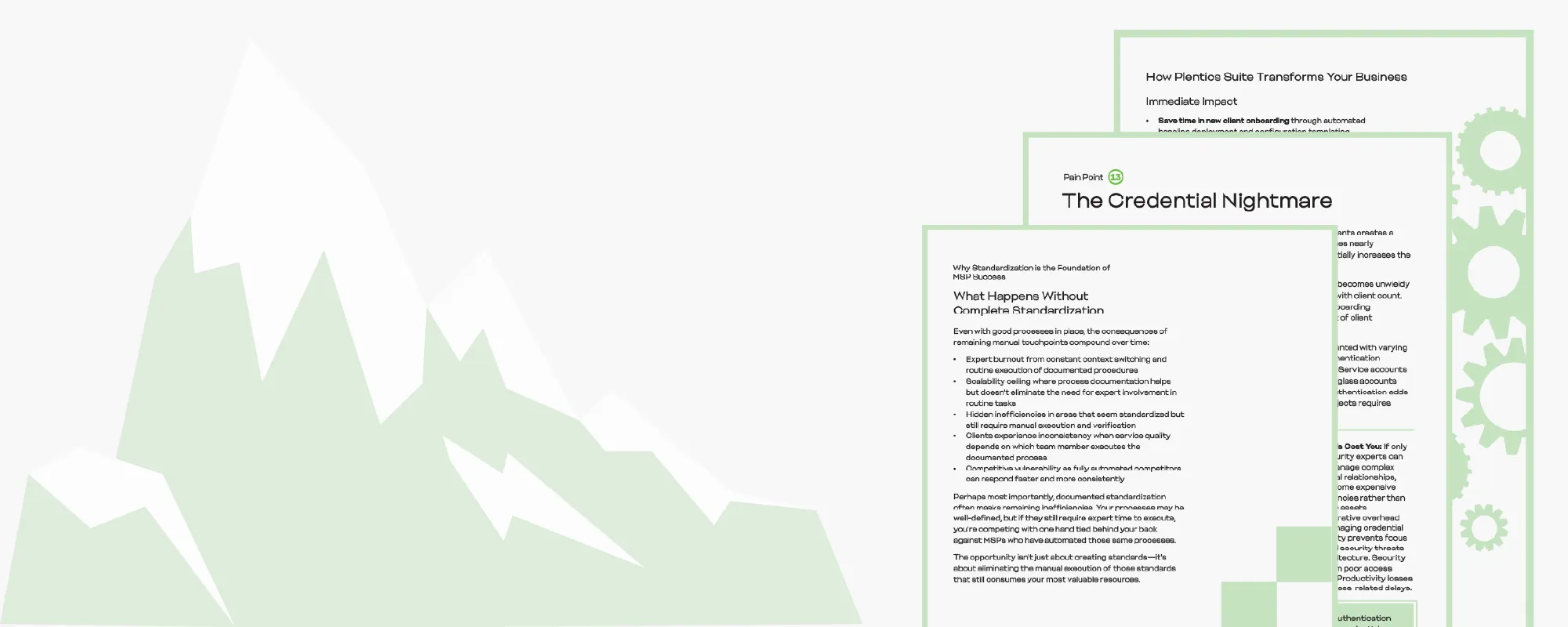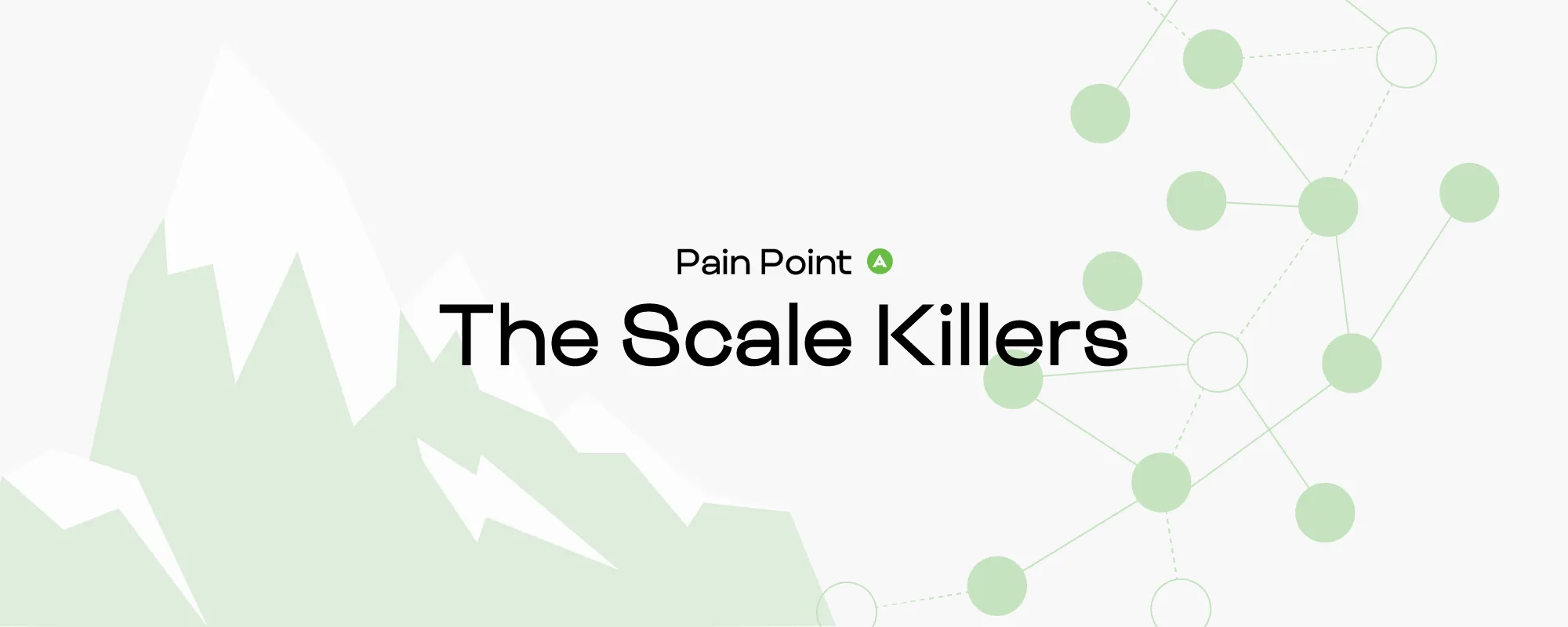The managed services industry is experiencing unprecedented growth. Market projections show the global MSP market doubling or even tripling by 2030. Yet many MSPs find themselves trapped in an uncomfortable paradox: the very success that brought them growth is now threatening to break their operations.
If you're running an MSP, you've likely to experience this firsthand. Each new client should represent pure opportunity, but instead, they often bring exponential complexity. Your most skilled technicians are drowning in browser tabs, manually switching between client environments, and spending their valuable expertise on tasks that junior staff should be handling.
Ready to Break the Scaling Paradox?
We've compiled a comprehensive analysis of the 16 most critical pain points limiting MSP growth, along with practical solutions that leading MSPs are implementing today. This isn't theoretical, it's based on real operational transformations happening across the industry.

Download 👇 our complete executive guide to discover exactly how these challenges impact your business and what you can do about them. The 45-page analysis includes business impact assessments, technical realities, and proven solutions for each pain point.
MSPs are splitting into two camps: those building scalable Microsoft 365 -native operations and those stuck in manual firefighting. Winners are building automated, scalable operations that multiply their team's effectiveness. The question is: which group will you be in?
Download the guide
The Hidden Cost of Manual Operations
A look at everyday life at MSP office tells a sobering story. Technicians lose staggering amounts of their productive time to context switching between clients’ Intune and other Microsoft 365 admin portals. Your senior experts, the people you hired to architect solutions and solve complex problems, are instead navigating identical-looking admin centers and double-checking which tenant they're actually working in.
This isn't just inefficiency. It's a scalability killer that makes every additional client exponentially more complex to manage. While your competitors are building automated, standardized operations that multiply their team's effectiveness, manual processes are keeping you trapped in a cycle of expensive hiring and expert burnout.
The Five Categories of MSP Growth Killers
Through extensive research with leading European MSPs, we've identified 16 critical pain points that fall into five distinct categories:

Scale Killers prevent efficient growth by forcing dependency on expensive, multi-skilled experts for routine tasks. Manual multi-tenant management, configuration chaos, and onboarding bottlenecks directly limit how fast you can grow.
Examples:
- A technician spends 45 minutes switching between 12 Intune tenants to push the same configuration, risking wrong-tenant errors every time.
- An urgent policy change gets applied to the wrong client tenant, triggering a company-wide outage.
- Quarterly audits reveal drift across five clients’ security baselines, requiring two days of senior engineer time just to document and fix.

Efficiency Drains waste your most valuable resources on repetitive work. Win32 application packaging in Intune, policy deployment complexity, and the constant treadmill of Graph API updates consume expert time that should be driving strategic Microsoft 365 initiatives.
Examples:
- Senior endpoint management engineers spend hours each week monitoring and deploying third party application updates tenant by tenant, instead of focusing on architecture.
- Customer tenant configurations vary across clients, forcing manual work and eating into billable hours.

Blind Spots create reactive management patterns where problems are discovered by clients first. Without cross-tenant Intune analytics and reliable alerts, your team spends time firefighting end-user incidents in Microsoft 365 environments instead of preventing issues proactively.
Examples:
- Intune fails to send alerts for a broken Windows Update policy the MSP only finds out after dozens of laptops miss critical patches.
- Client users raise tickets before the MSP sees issues, making the MSP look reactive and unreliable.

Security Gaps multiply vulnerabilities as you scale. Credential management becomes exponentially complex, and maintaining consistent security postures across dozens of client environments requires constant expert attention.
Examples:
- A technician leaves the company, and their old tenant logins aren’t fully revoked, leaving hidden security risks.
- A client can’t install a critical app for two weeks because the MSP’s packaging backlog has grown out of control.

The Talent War forces expensive hiring decisions while decreasing employee retention. The traditional approach of scaling staff linearly with client growth becomes unsustainable when expertise requirements are complex and specialists are scarce.
Examples:
- Adding just 10 new clients requires hiring two more senior Intune engineers, erasing margin gains.
- Growth stalls because recruitment pipelines for qualified Intune talent are dry for six months.
- Each client has custom Microsoft 365 and Intune configurations — maintenance and troubleshooting takes 3x longer because no two tenants look the same.
- Engineers can’t cross-cover each other’s clients because each setup is unique, leading to support delays and burnout.
Why Traditional Solutions Fail at Scale
Many MSPs attempt to solve these challenges through familiar approaches: better documentation, more detailed procedures, additional training, or PowerShell automation. While these help initially, they don't address the fundamental issue.
The problem isn't lack of processes, it's that even well-documented processes still require expert execution. When only your most experienced technicians can safely work across multiple client environments, they become bottlenecks regardless of how well your procedures are documented.
Meanwhile, PowerShell and Graph API automations break with Microsoft’s frequent Intune updates, forcing experts back into repetitive troubleshooting instead of building scalable Microsoft 365 services. Custom automation often creates more complexity than it solves.
The Talent Multiplication Alternative
Forward-thinking MSPs are taking a different approach. Instead of competing for increasingly scarce and expensive talent, they're multiplying the effectiveness of their existing teams through intelligent automation and standardization.
With the right approach, junior staff can safely handle 80 % of routine multi-tenant operations. Complex Intune tasks — from Conditional Access policy rollouts to third party application patching — become guided workflows that don’t require deep Microsoft 365 expertise. Your senior experts finally get to focus on architecture, strategic planning, and genuine problem-solving—the work you hired them to do.
This isn't about replacing human expertise. It's about leveraging that expertise at the right level. When routine operations are automated and complex processes are standardized, your most valuable people can focus on building competitive advantage rather than managing operational complexity.
Competitive Reality Check
The transformation window won't remain open indefinitely. MSPs implementing standardized, automated operations are already capturing market share while others struggle with traditional approaches. The competitive advantages are building compound over time, creating sustainable differentiation that becomes increasingly difficult to match.
Early adopters gain momentum that late adopters find nearly impossible to overcome. Every month you delay standardization, competitors gain ground that becomes harder to recover.
What Leading MSPs Are Doing Differently
The most successful MSPs have moved beyond documented standardization to intelligent automation. They've eliminated manual touchpoints that consume expert time, created single-pane-of-glass access to all client environments, and built proactive monitoring that identifies issues before they cause client impact.
These operational foundations enable them to take on new clients without proportional staff increases, deliver consistent service quality regardless of team size, and respond to client needs faster and more reliably than competitors still operating manually.
Building Your Path Forward
The transition from manual to automated operations doesn't happen overnight, but it can begin immediately. The key is understanding which pain points are limiting your growth most significantly and addressing them systematically.
Some MSPs start with comprehensive visibility across their managed environments to identify optimization opportunities. Others begin with rapid deployment capabilities that transform client onboarding from weeks to minutes. The specific starting point matters less than beginning the transformation.
What matters most is recognizing that operational excellence isn't just about efficiency, it's about building sustainable competitive advantage in a rapidly evolving market.
Download the pain point analysis






